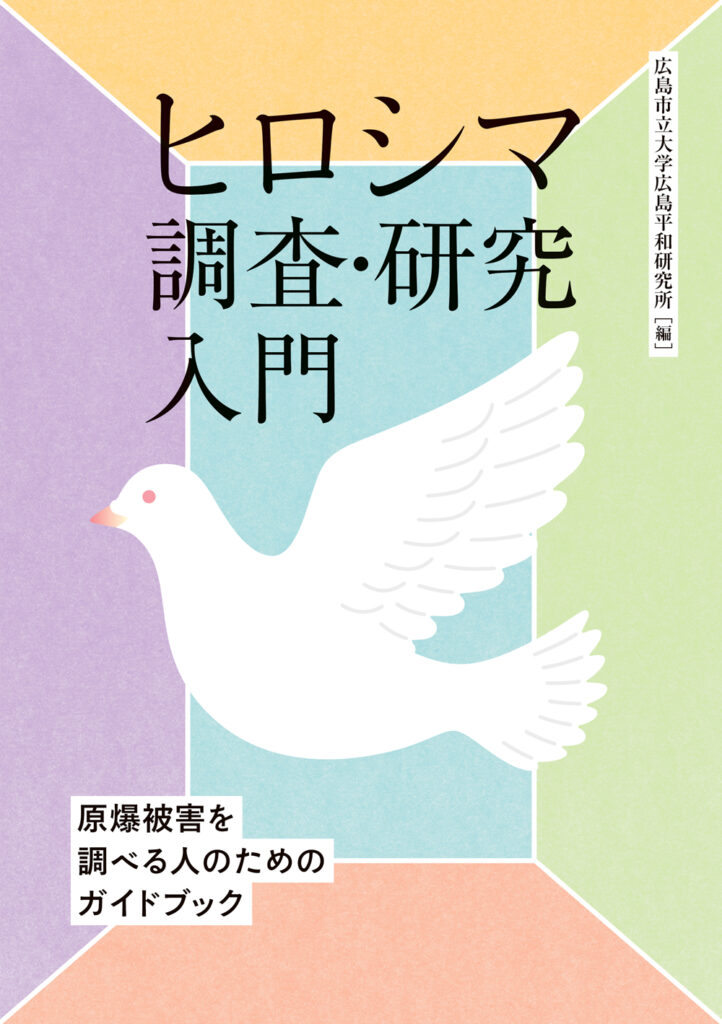竹本 真希子(准教授)

広島平和研究所(平和研)では2025年3月、『ヒロシマ調査・研究入門――原爆被害を調べる人のためのガイドブック』を刊行した。本書は被爆80年・広島市立大学開学30周年記念事業として出版されたもので、平和研の教員および本学関係者が執筆した。原爆被害を調べるための調査・研究のガイドとなることを目指したものである。
1章「調査・研究ガイド」では、広島について調べるための入り口となるデータベースや基本文献、さまざまな種類の資料ごとの調べ方を紹介している。2章「広島で調べる」は、広島市にある原爆被害に関連する資料を保存・展示する施設や、広島県内で戦争について学ぶことのできる施設など、実際に原爆被害や戦争被害を現地で調べるという視点から、48施設を紹介している。3章「広島を体感する」では、「8月6日をめぐる」と「被爆の痕跡をたどる」の二つのテーマを取り上げ、8月6日前後に広島のさまざまな場所で行われる28の慰霊行事のほか、被爆体験を聞いたり、広島と原爆被害についてさらに調べたりするための情報を提供している。原爆について調べようと思うと、まず、広島平和記念資料館や長崎原爆資料館の訪問が思い浮かぶ。だが、広島に来ることができなくても、日本各地で原爆について学べる施設がある。4章「日本で調べる」では、こうした日本国内の原爆被害や核問題に関する展示施設、アーカイブズなどの28施設を紹介している。最終章となる5章「原爆被害・核問題を知る扉」では、ヒロシマ研究に一歩踏み出すための材料として、原爆や核問題に関するさまざまな研究テーマやグローバルな視点、研究文献の情報を掲載している。
被爆から80年を迎えた今年、2024年10月の日本原水爆被害者団体協議会(日本被団協)のノーベル平和賞受賞や核に対する危機感から、広島、長崎に対する関心は高まっている。本書の出版によって、多くの人々が「ヒロシマ」について考える機会を提供できれば幸いである。
Introduction to Hiroshima: Survey and Research
[Hiroshima chōsa kenkyū nyūmon: genbaku higai wo shiraberu hito no tameno gaidobukku]
Makiko Takemoto (Associate Professor)

This article is forthcoming in the 68th issue of Hiroshima Research News.
Click here to see past issues of the Newsletter.
Please also refer to the Publications page.
In March 2025, the Hiroshima Peace Institute (HPI) published a new book titled Introduction to Hiroshima: Survey and Research. It was published to commemorate the 80th anniversary of the atomic bombings and the 30th anniversary of the founding of Hiroshima City University. The articles in the book were written mainly by faculty members of HPI and other members of Hiroshima City University. The book is intended to serve as an essential guide for surveys and research related to the atomic bombings and Hiroshima.
Chapter 1 titled “Research Guide” introduces key databases and foundational literature for beginning research on Hiroshima. It also provides guidance on how to approach different types of research materials. Chapter 2, “Research in Hiroshima,” highlights important facilities in the city of Hiroshima and Hiroshima Prefecture that preserve and exhibit materials related to the atomic bombing. These facilities include museums where visitors can learn about the history of war and Hiroshima’s involvement in it.
Chapter 3, “Experiencing Hiroshima,” is organized around two sub-themes, “August 6” and “Tracing the Imprints of the A-bomb.” This chapter describes 28 commemorative events held annually around August 6 at various locations in Hiroshima. It also offers guidance for further research on Hiroshima and the atomic bombing including how to interview Hibakusha and how to find guided tours of the Hiroshima Peace Memorial Museum and Hiroshima Peace Memorial Park.
When people begin research on the atomic bombings, the first thing that often comes to their mind is to visit the Hiroshima Peace Memorial Museum and Nagasaki Atomic Bomb Museum. However, even if you are unable to visit Hiroshima, there are still many opportunities for such learning. Across Japan, numerous facilities offer insights into the atomic bombing and the history of war. Chapter 4, “Research in Japan,” introduces 28 facilities in Japan, including peace museums, exhibitions and archives on nuclear issues.
Chapter 5 is titled “Doors to Understanding Atomic bombings and Nuclear Issues.” As the final chapter, it suggests various themes for further research on nuclear issues and offers global perspectives on them. An essential and comprehensive bibliography on Hiroshima is also included, providing valuable resources for those seeking to deepen their study of Hiroshima.
In 2025, the 80th anniversary of the atomic bombings, global interest in Hiroshima and Nagasaki is growing, particularly due to the Nobel Peace Prize awarded in October 2024 to the Japan Confederation of A- and H-bomb Sufferers Organizations (Nihon Hidankyo), as well as recent nuclear tensions in international politics. We hope that the publication of this book will serve as an opportunity for people to reflect on the contemporary significance of Hiroshima.
